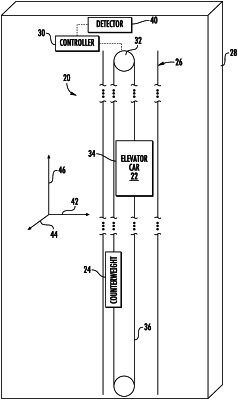| CPC B66B 5/022 (2013.01) [B66B 1/28 (2013.01); B66B 1/3407 (2013.01); B66B 1/3492 (2013.01)] | 21 Claims |

|
1. A method of controlling an elevator system situated in a hoistway of a building, the method comprising:
detecting sway of the building;
determining characteristics of the detected sway including a plurality of building sway frequencies and associated periods of the sway of the building, wherein determining the characteristics comprises determining an indication of an amplitude of movement, a frequency of the movement, and a direction of the movement;
determining a relationship between the characteristics of the sway of the building and a configuration of components of the elevator system;
determining an expected sway of an elongated member of the elevator system based on the determined characteristics; and
controlling at least one of position and movement of an elevator car in the hoistway based on the expected sway of the elongated member and based on the determined relationship including using a first control strategy when the determined characteristics comprise a first set of characteristics or a second control strategy when the determined characteristics comprise a second set of characteristics, wherein the first set of characteristics is different than the second set of characteristics and the first control strategy is different than the second control strategy, and wherein the direction comprises at least a side-to-side direction relative to the hoistway or a fore-aft direction relative to the hoistway, and wherein the first control strategy is used for the side-to-side direction and the second control strategy is used for the fore-aft direction.
|